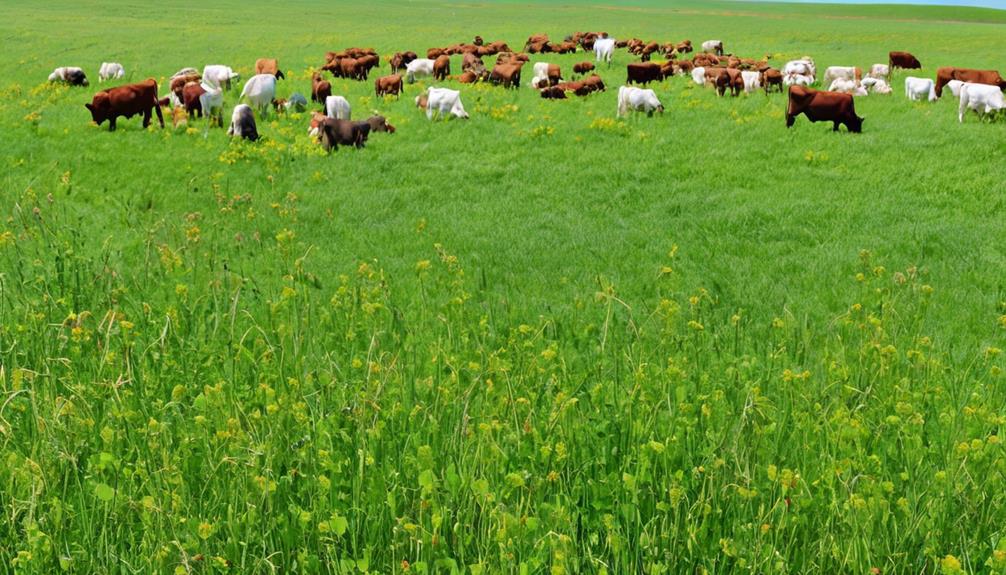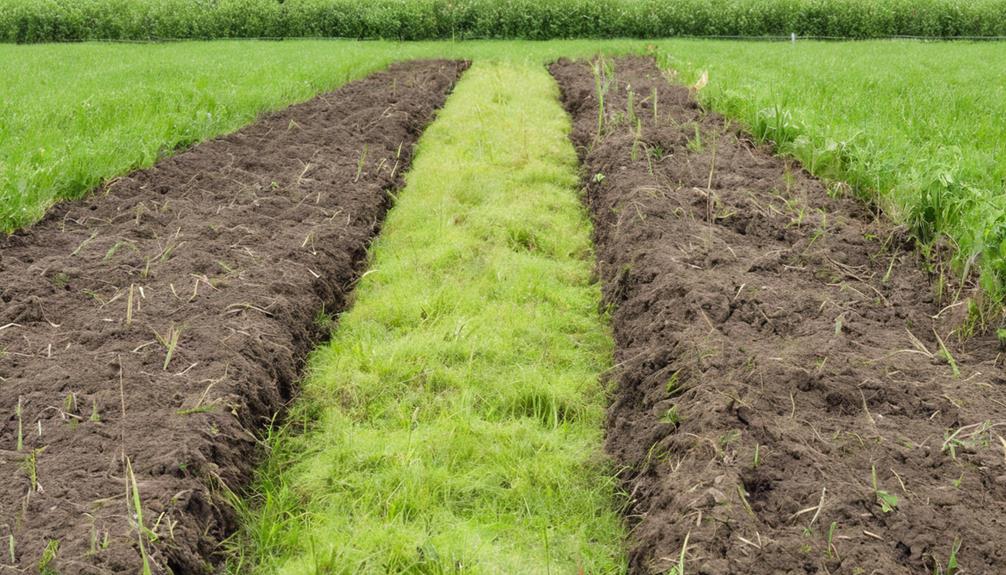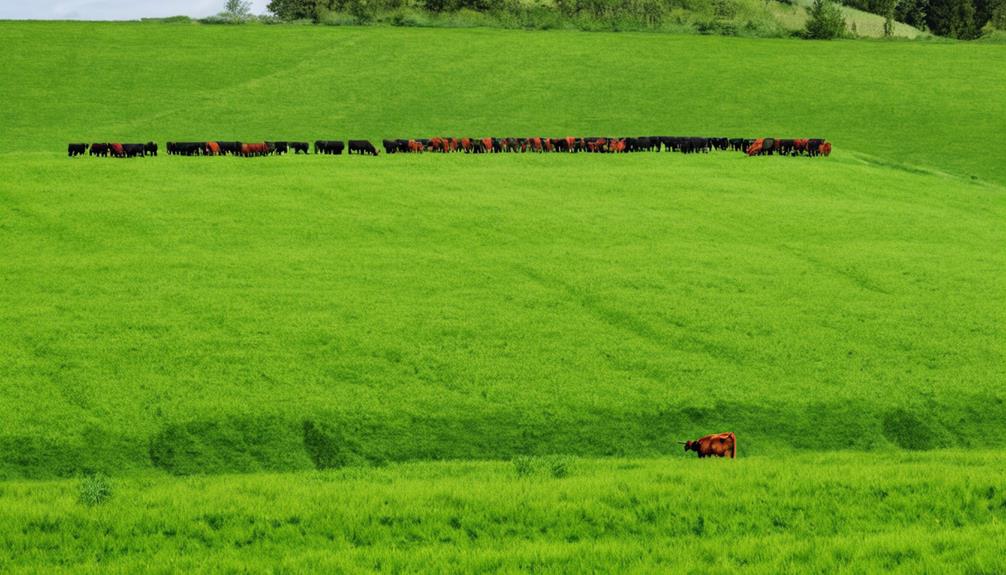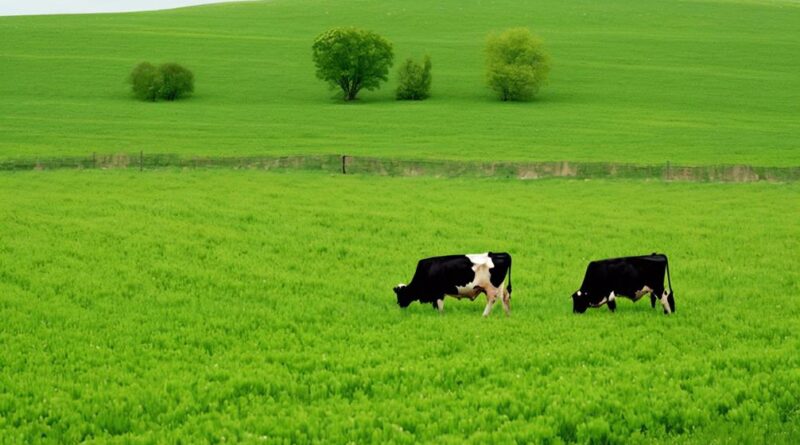Why Include Cover Crops in Cattle Grazing Systems?
Imagine your cattle grazing system as a well-oiled machine, with each component working together to maximize efficiency and productivity.
Now, picture cover crops as the crucial gears that keep this machine running smoothly.
But why exactly should you bother incorporating cover crops into your cattle grazing system?
Well, the answer lies in a multitude of benefits that go beyond just providing additional forage for your livestock.
Let's explore how cover crops can significantly impact the overall health and success of your grazing operation.
Benefits of Cover Crops in Grazing Systems

Cover crops in grazing systems offer numerous benefits, including improved soil health and increased forage availability for cattle. When it comes to livestock nutrition, cover crops play a crucial role in providing additional nutrients for grazing animals. These crops can serve as a source of high-quality forage, offering a diverse array of essential vitamins and minerals that contribute to the overall health and well-being of the cattle.
Grazing management is also significantly enhanced by the inclusion of cover crops. These crops help extend the grazing season by providing additional forage when traditional pastures may be less productive. This can be particularly beneficial during periods of drought or when pastures are undergoing restoration or reseeding. By incorporating cover crops into grazing systems, you can better manage the available forage, allowing for a more sustainable and efficient use of the land.
Furthermore, cover crops contribute to soil health, which in turn supports livestock nutrition. They help prevent soil erosion, improve soil structure, and increase organic matter content. This leads to a healthier and more productive grazing environment for the cattle. As the cover crops decompose, they release nutrients back into the soil, further enhancing its fertility.
Improving Soil Health With Cover Crops
Improving soil health with the incorporation of cover crops is essential for sustaining a productive grazing environment for your cattle. Cover crops play a crucial role in enhancing soil fertility by adding organic matter, nutrients, and beneficial microorganisms to the soil. These crops help in reducing soil erosion and compaction, improving water retention, and enhancing nutrient cycling. By promoting soil health, cover crops create a more favorable environment for the growth of forage plants, which in turn provides better grazing opportunities for your cattle.
Carbon sequestration is another significant benefit of using cover crops. These crops capture carbon dioxide from the atmosphere and store it in the soil in the form of organic matter. This process helps in mitigating climate change by reducing the amount of carbon dioxide in the atmosphere. Additionally, increased organic matter in the soil enhances its structure and stability, leading to improved water infiltration and reduced runoff.
Incorporating cover crops into your grazing system can lead to long-term benefits for both your soil and your cattle. By enhancing soil fertility and promoting carbon sequestration, cover crops contribute to a more sustainable and resilient grazing environment. As a cattle grazier, integrating cover crops into your grazing system can ultimately lead to healthier soils, improved forage quality, and better overall productivity for your livestock.
Enhancing Forage Diversity and Quality

To further enhance the productivity of your grazing system, consider diversifying and improving the quality of forage available for your cattle. Enhancing forage diversity and quality can have a significant impact on the overall health and performance of your cattle. Here's how you can achieve this:
- Enhancing Biodiversity: Introducing cover crops into your grazing system can greatly enhance the biodiversity of forage available to your cattle. Different cover crops provide a variety of nutrients and can thrive in different environmental conditions. This diversity not only offers a wider range of nutrients to your cattle but also helps in maintaining a balanced ecosystem within your grazing area.
- Maximizing Nutrition: By incorporating a mix of cover crops such as legumes, grasses, and broadleaf plants, you can maximize the nutritional value of the forage available to your cattle. Legumes, for example, fix nitrogen in the soil, providing a natural source of this essential nutrient for the other plants in the grazing system. This results in higher-quality forage that can contribute to improved cattle health and productivity.
- Improving Forage Quality: Cover crops can also improve the overall quality of the forage by providing a wider range of textures, flavors, and nutrient profiles. This can lead to increased palatability and consumption by your cattle, ensuring they receive a well-rounded diet that meets their nutritional needs.
Managing Grazing Pressure With Cover Crops
Considering the grazing pressure on your land, incorporating cover crops can effectively regulate the forage availability for your cattle. Grazing management becomes more efficient with the strategic use of cover crops. By carefully selecting and managing cover crops, you can control the timing and intensity of grazing, ensuring that your cattle have a continuous supply of high-quality forage while also preventing overgrazing. This approach not only benefits the livestock but also contributes to the overall health of your pastures.
In addition to regulating grazing pressure, cover crops play a significant role in maintaining soil fertility. As cattle graze, cover crops protect the soil from erosion, improve its structure, and enhance nutrient cycling. The root systems of cover crops help to build organic matter in the soil, promoting microbial activity and increasing its water-holding capacity. These factors contribute to improved soil fertility, which in turn supports the growth of healthier forage for your cattle.
Effective grazing management with cover crops involves careful monitoring of forage availability, animal behavior, and overall pasture health. By adjusting grazing patterns and durations, you can optimize the use of cover crops to meet the nutritional needs of your cattle while preserving the long-term productivity of your land.
Reducing Erosion and Runoff

To maintain the health of your pastures while promoting soil fertility, reducing erosion and runoff is essential in sustaining the productivity of your land. By incorporating cover crops into your cattle grazing systems, you can effectively minimize erosion and runoff while promoting soil conservation and water retention. Here's how cover crops contribute to reducing erosion and runoff:
- Soil Conservation: Cover crops play a crucial role in preventing soil erosion by protecting the soil surface from the impact of raindrops and wind. Their extensive root systems help bind the soil together, reducing the risk of erosion caused by water runoff. This, in turn, preserves the integrity of your pastures and ensures the long-term productivity of your land.
- Water Retention: Cover crops enhance the soil's ability to retain water, reducing the risk of runoff during heavy rainfall. This not only helps to maintain soil moisture levels for your grazing cattle but also contributes to environmental sustainability and natural resource management by preventing excess water runoff that can carry away valuable topsoil and nutrients.
- Environmental Sustainability and Natural Resource Management: By minimizing erosion and runoff, cover crops contribute to the overall environmental sustainability and effective management of natural resources on your grazing land. This proactive approach not only benefits your cattle grazing systems but also supports the broader ecological balance of the surrounding environment.
Incorporating cover crops into your grazing systems is a proactive and effective strategy for reducing erosion and runoff, promoting soil conservation, and enhancing water retention for long-term land productivity and environmental sustainability.
Integrating Cover Crops for Nutrient Cycling
Consider integrating cover crops into your cattle grazing systems to enhance nutrient cycling, promoting soil fertility and sustainable land management. By incorporating cover crops, you can maximize production while minimizing inputs, thus promoting sustainability and increasing profitability.
Cover crops play a crucial role in nutrient cycling within grazing systems. These crops help in capturing and recycling nutrients, particularly nitrogen, which is essential for plant growth. By harnessing the nitrogen-fixing capabilities of certain cover crops, you can reduce the need for synthetic fertilizers, cutting down on input costs while promoting soil health. Additionally, the deep root systems of many cover crop species help to scavenge nutrients from deeper soil layers, preventing nutrient leaching and making these nutrients available for subsequent grazing or cash crops.
Furthermore, integrating cover crops into your cattle grazing systems can improve the overall soil organic matter content. This enhances soil structure, water retention, and microbial activity, leading to better nutrient availability for both the cover crops and subsequent cash crops or forage. As a result, you can achieve higher forage yields, better animal performance, and improved overall farm productivity.
Extending Grazing Seasons With Cover Crops

Looking to capitalize on the benefits of cover crops in your cattle grazing systems? Extending grazing seasons with cover crops can optimize nutrient cycling, enhance soil fertility, and promote sustainable land management, ultimately leading to increased profitability and productivity.
Here's how extending grazing seasons with cover crops can benefit your cattle and your land:
- Grazing Management: Cover crops offer an opportunity to extend the grazing season by providing additional forage for your livestock. By strategically planting cover crops that mature at different times, you can ensure a continuous supply of high-quality forage throughout the year. This allows you to better manage your grazing rotation, reduce the need for supplementary feed, and maintain healthy pastures.
- Livestock Nutrition: Incorporating cover crops into your grazing system can improve the nutritional quality of the available forage. Different cover crops can offer a diverse range of nutrients, ensuring that your livestock receive a well-balanced diet. This can lead to improved animal health, enhanced weight gain, and overall better performance.
- Soil Health: Extending the grazing season with cover crops also has significant benefits for soil health. The additional root growth and organic matter from cover crops help to improve soil structure, increase water infiltration, and reduce erosion. This contributes to enhanced soil fertility, which in turn supports the growth of healthier and more nutritious forage for your livestock.
Economic Considerations for Cover Crops
How do cover crops in cattle grazing systems impact your bottom line?
Incorporating cover crops into your grazing system can have a significant impact on your farm's profitability. While there may be initial costs associated with planting cover crops, the long-term benefits can far outweigh these expenses. By maximizing the use of cover crops, you can extend the grazing season for your cattle, reducing the need for supplemental feed during the winter months. This can lead to substantial cost savings on feed and labor, ultimately increasing your bottom line.
Furthermore, cover crops contribute to farm sustainability by improving soil health and fertility. Healthier soils lead to increased productivity and resilience, reducing the need for expensive fertilizers and other inputs. Additionally, cover crops help control erosion, manage weeds, and enhance water retention, all of which contribute to long-term farm sustainability.
Incorporating cover crops into your grazing system can also have financial benefits beyond the farm. By improving soil health and reducing the need for synthetic inputs, you may be able to market your products as more sustainable and environmentally friendly, potentially attracting premium prices from eco-conscious consumers.
Frequently Asked Questions
How Do Cover Crops Impact the Behavior and Health of Cattle in Grazing Systems?
Cover crops positively impact cattle behavior by providing diverse forage, reducing stress, and improving grazing health. They offer nutritional benefits and create a more natural environment, leading to healthier and more content cattle.
What Are the Potential Drawbacks or Challenges of Integrating Cover Crops Into Cattle Grazing Systems?
When integrating cover crops into cattle grazing systems, challenges may arise, such as managing crop rotations, potential limitations in forage quality, and soil health. Implementing effective management strategies can help address these issues.
Are There Specific Types of Cover Crops That Are Better Suited for Certain Types of Cattle or Grazing Environments?
When choosing types of cover crops for cattle, consider cattle preferences, soil health, and grazing management. Certain cover crops can enhance nutrient cycling and offer environmental benefits. Matching cover crops to grazing environments optimizes cattle and soil health.
What Impact Do Cover Crops Have on the Overall Carbon Footprint of Cattle Grazing Systems?
Cover crops have a positive impact on soil health and contribute to a reduction in methane emissions. They help sequester carbon, enhancing the overall carbon footprint of cattle grazing systems. This practice benefits both the environment and your herd.
How Do Cover Crops Affect the Overall Biodiversity and Ecosystem Health of Grazing Areas?
Cover crops enhance biodiversity and improve soil fertility in grazing areas. They support a healthier ecosystem by providing habitat for beneficial insects and microorganisms. The increased diversity of plant species also contributes to overall ecosystem health.
Conclusion
So, why include cover crops in your cattle grazing system?
Well, cover crops offer a range of benefits, from improving soil health and enhancing forage diversity to managing grazing pressure and reducing erosion.
They also help with nutrient cycling and can extend your grazing season.
Plus, considering the economic benefits, it's clear that cover crops are a valuable addition to any grazing system.
So, go ahead and give cover crops a try – your cattle and your land will thank you!
